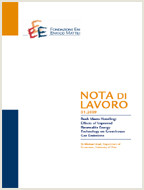The Potential of REDD+ for Carbon Sequestration in Tropical Forests: Supply Curves for carbon storage for Kalimantan, Indonesia

13.10.2015
Yonky Indrajaya (Environmental Economics and Natural Resources Group – Wageningen University); Edwin van der Werf (Environmental Economics and Natural Resources Group – Wageningen University, CESifo); Hans-Peter Weikard (Environmental Economics and Natural Resources Group – Wageningen University); Frits Mohren (Environmental Economics and Natural Resources Group – Wageningen University); Ekko C. van Ierland (Environmental Economics and Natural Resources Group – Wageningen University)
Q2, Q23
REDD+, Carbon Credits, Carbon Sequestration, Sustainable Forest Management, Reduced Impact Logging, Optimal Forest Management, Carbon Price
Climate Change and Sustainable Development
Carlo Carraro
Suggested citation: Indrajaya, Y., E. van der Werf, H.-P. Weikard, F. Mohren, E. C. van Ierland, (2015), ‘The Potential of REDD+ for Carbon Sequestration in Tropical Forests: Supply Curves for carbon storage for Kalimantan, Indonesia’, Nota di Lavoro 81.2015, Milan, Italy: Fondazione Eni Enrico Mattei
